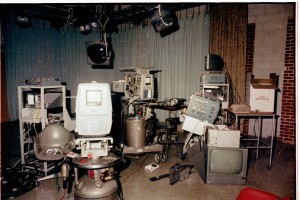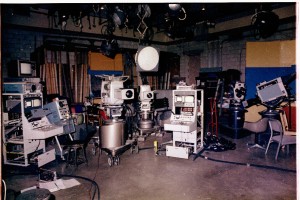Once we had cameras functioning in two studios, we turned our attention to a couple of Norelco PC-60s locked away in a storage room. There they sat, resting upon a couple of (leaky) TVP pneumatic pedestals. At that time, the shop was a small room next door to Control “B”. The students must have been gone for the summer, because we took over most of studio “A” with a vow to get them working and on-line. As part of writing this post, I located Greg McMurry. He was one of the engineers who preceded me. He told me that he had procured these cameras in hopes of “going color” after a false-start involving a couple of RCA TK-42s.
The cameras had been in the storage room for so long with irises open that an image of the storage room door was permanently captured in the pickup tubes of one of the cameras. This set me off on a “Plumbicon collection campaign” that taught me how generous some broadcasters are when it comes to helping a fledgling educational facility. 
The above photos were taken as Bob Swanner dug elbow-deep into these cameras with some serious dedication to getting them operational. I believe the blue chassis are after-market encoders, and that the original Norelco encoders were not part of these camera chains. Besides the Conrac RHA monitor sitting on the floor, there is a Ball Brothers (Miratel) monitor in the background. The Mason jar manufacturer was also into video monitors and other equipment. The cameras likely put out video when first fired up, but it is for certain that they were in need of tubes, serious tweaking, all new registration pots, and about 2 gallons of contact cleaner.
In speaking of the generosity of other broadcast engineers, our search for “gently used” (this means pin-holes smaller than .22 cal bullet holes) Plumbicon tubes took us to WJET-TV in Erie, Pennsylvania. There, in a quonset hut on the outskirts of town…and directly under the transmitting tower, we were given at least one additional PC-60 camera chain, manuals, boxes of Plumbicons, and genuine “fellow broadcaster hospitality” that you remember for the rest of your life.
If you want to see PC-60s in overwhelming depth and detail, visit this amazing site: Eyes of a Generation.

I think I might cry! Memories… UMD/RTVF/1992
hi John: Swell stuff here…keep the narrative running.
Very enjoyable (even though I came late & the party ended with me…).
Hi John,
This one tickles a memory for me. I worked very briefly in the RTVF tech center, it must have been in the fall of 1976 or so, perhaps before you were there. I recall Studio A being jammed full of donated equipment. Besides the PC-60s you show here, there were a number of TK-41s and 42s, plus at least one if not two ancient RCA VTRs, the early ones that were contained in six racks each.
I’ve often wondered what happened to it all, it should have gone to a museum but was most likely scrapped.
Thanks for the comment, Mike. The ancient RCA multi-rack VTRs must have been removed from Studio “A” before I got there. They had been in use when I was a night student several years earlier. The TK-42s were purchased used from Herbach and Rademan, a Philadelphia surplus house. This is information I gleaned from Gene Weiss in a telephone interview. I don’t know where the TK-41 came from. When I arrived, the TK-42s were in a storage room. A few years later after we had some TK-76 cameras, we arranged to trade those 42s for some nice long lengths of multi-core for the 76s. Over the years, I have been approached by several collectors wanting to know if I think those 42s are still at U of Md. They came from a Boston TV station, or so the lore goes. For the life of me, I can’t remember who we traded those to….but with multicore cables costing $10/ft back then….we made a great deal for the particular time.
J
The after market encoders were probably from 3M Mincom Division, Camarillo, CA. They made encoders for both RCA and Phillips. Telemation also made after market encoders but don’t believe they were blue.
I have some Norelco PC-60 equipment. Anyone interested? Chad